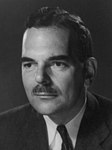| |||||||||||||||||||||||||||||||||||||||||||||||
1,057 delegates to the Republican National Convention 529 (majority) votes needed to win | |||||||||||||||||||||||||||||||||||||||||||||||
|---|---|---|---|---|---|---|---|---|---|---|---|---|---|---|---|---|---|---|---|---|---|---|---|---|---|---|---|---|---|---|---|---|---|---|---|---|---|---|---|---|---|---|---|---|---|---|---|
| |||||||||||||||||||||||||||||||||||||||||||||||
 Results map by state. | |||||||||||||||||||||||||||||||||||||||||||||||
| |||||||||||||||||||||||||||||||||||||||||||||||
From March 14 to June 11, 1944, voters of the Republican Party selected delegates to the 1944 Republican National Convention for the purpose of selecting their nominee for president in the 1944 election at the 1944 Republican National Convention held from June 26 to June 28, 1944, in Chicago, Illinois.[2]
Although the result of the elections were inconclusive, maneuvering by the delegates secured the nomination for Governor of New York Thomas E. Dewey before they convened in Chicago. Dewey easily overcame a challenge from Governor of Ohio John W. Bricker and was nominated on the first ballot. In a bid to maintain party unity, Dewey, a moderate, chose the conservative Bricker as his running mate; Bricker was nominated by acclamation.
- ^ a b c d "Dewey Delegate Count is 138 Short of Needs". The Fresno Bee. 11 Jun 1944. p. 7. Retrieved 31 Jan 2023.
- ^ Kalb, Deborah (2016-02-19). Guide to U.S. Elections - Google Books. ISBN 9781483380353. Retrieved 2016-02-19.



